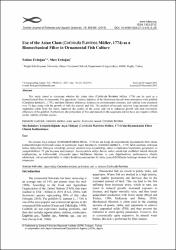Use of the Asian Clam (Corbicula flumineaMüller, 1774) as a Biomechanical Filter in Ornamental Fish Culture
Abstract
Bu çalışma Asya midyesi (Corbicula fluminea Müller, 1774)'nin süs balığı akvaryumlarında biyomekanik filter olarak kullanılabilirliğini belirlemek amacı ile yapılmıştır. Japon balıkları ile (Carassius auratus L., 1758) farklı oranlarda stoklanan tatlısu midyesinin, filtrasyon verimliliği, çevresel streslere karşı dayanıklılığı, midye ve balıkların büyümeleri, gelişmeleri ve yaşayabilirlikleri 75 gün boyunca incelenmiştir. Akvaryumlara midye ilavesi, sudan askıda katı maddeleri önemli düzeyde uzaklaştırmış, su kalitesindeki iyileşmeler japon balıklarının büyüme ve yem değerlendirme performansını olumlu etkilemiştir. Akvaryumlarda balık ve midye kombinasyonunun her iki türün yaşayabilirliklerine herhangi olumsuz bir etkisi olmamıştır This study aimed to determine whether the Asian clam (Corbicula fluminea Mü ller, 1774) can be used as a biomechanical filter in ornamental fish aquariums. Various densities of this freshwater mussel were maintained with goldfish (Carassius auratus L., 1758), and their filtration efficiency, tolerance to environmental stressors, and viability were examined over 75 days along with the growth of both the mussels and fish. The addition of mussels removed large amounts of total suspended solids from the water, improved the quality of the water, and led to enhanced growth and feed conversion efficiency of the goldfish. Furthermore, the polyculture of fish and mussels in the aquariums did not have any negative effects on the viability of either species.


















